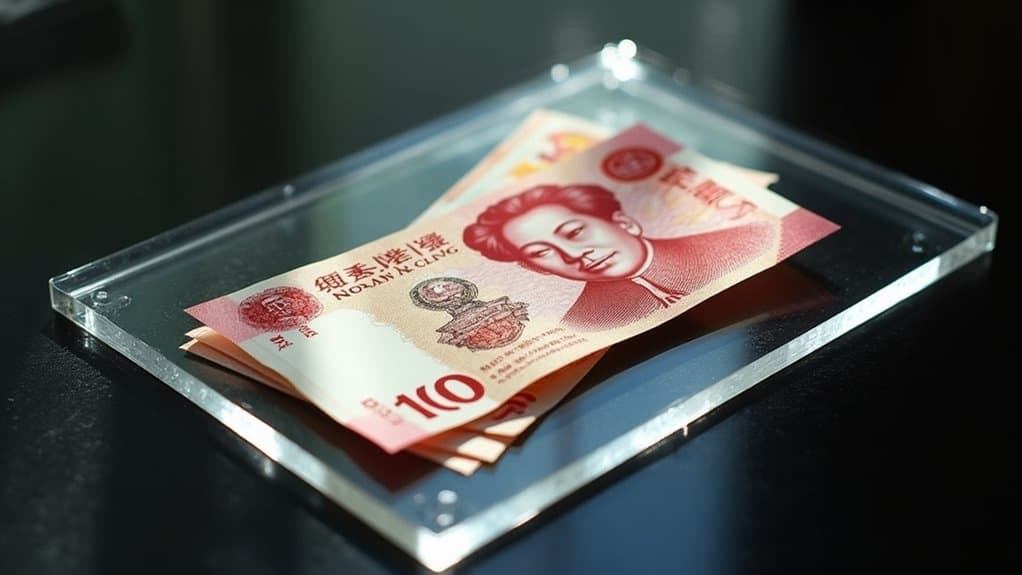Currency pegging means a country’s central bank locks its currency’s value (like the Belize dollar) directly to a stable benchmark – often the US dollar, euro, or gold. Officials desperately defend this rate using huge reserves to buy or sell domestic currency, preventing volatile swings that scare investors or spike import prices. Over 66 nations, including oil giants like Saudi Arabia, use dollar pegs to tame inflation and enhance trade credibility. This provides vital short-term stability but demands enormous discipline and deep pockets when markets bet against you – remember Argentina’s collapse proving this strategy isn’t foolproof. More perspectives on making this high-wire act work follow shortly.
Understanding the Currency Peg Concept
Currency pegging, a government policy linking its currency’s exchange rate to a stable ‘anchor’ like the US dollar, creates an essential buffer against wild price swings when you’re trading internationally.
Imagine your currency firmly pegged – its value locked to, say, the dollar under a fixed exchange rate. This directly combats inflation imported via foreign exchange movements and brings predictable exchange rates, fundamental for smooth trade.
Think of a rock-solid dollar peg as a high-security fence, while softer pegs act more like a picket boundary; both demand constant central bank vigilance.
Maintaining this stability isn’t passive – central banks actively buy or sell reserves, making this monetary policy tool surprisingly hands-on, involving precise interventions if the rate drifts.
Stability’s often boring, yet essential.
Motivations for Implementing a Currency Peg
Recall how central banks actively battle to maintain a fixed rate. You’ll see nations implement a currency peg primarily for economic stability.
By locking their exchange rate, often to the dollar, they reduce uncertainty for trade and guarantee competitive pricing for exports—vital for countries like Belize or the UAE.
Developing nations also peg to guard against inflation and stabilize fragile monetary systems. Sometimes a soft peg offers significant flexibility without sacrificing the anchor.
Importantly, a successful peg, like Saudi Arabia’s riyal since 1986, promotes foreign investment by signalling reliability. It makes your economy predictable, avoiding abrupt shocks.
The Role of the US Dollar in Global Pegging
While implementing a currency peg typically aims for stability, the US Dollar becomes the dominant anchor choice globally. Over 66 nations use US Dollar currency pegs to shield against inflation and foreign exchange market chaos.
Why this dominance? First, fixed exchange rates simplify international trade. Also, for oil giants like Saudi Arabia (pegged since ’86), it hedges against volatile commodity prices.
Caribbean nations peg to encourage foreign investment and economic growth. Significantly, tying to the USD helps maintain competitive export prices, essential for trade-dependent economies.
This anchor grants instant credibility in turbulent markets, stabilizing nearly forty percent globally.
Mechanisms of Maintaining a Fixed Exchange Rate
To keep currencies locked at fixed rates, central banks actively intervene in forex markets—like vigilant umpires calling the lines.
You’ll see them constantly manage the currency value relative to an anchor (often the US dollar). Their toolkit involves both direct market actions and adjustments to broader monetary policy to counteract market pressures and defend the pegged level.
- Foreign Exchange Intervention: Buying/selling domestic currency using foreign exchange reserves directly to counter supply/demand shifts.
- Reserves as Ammo: Large reserves provide the firepower for sustained intervention against speculative attacks or trade imbalances.
- Monetary Policy Alignment: Adjusting interest rates or reserve requirements influences currency attractiveness, supporting the fixed exchange rate target.
- Economic Vigilance: Continuously monitoring inflation, trade balance, and reserve levels determines if a soft peg needs tweaking or intervention escalates.
Economic Advantages of Currency Pegging
When central banks successfully defend a peg, they’re not just smoothing volatility; they revel in tangible economic gains paid precisely in the form of increased trade and investment.
Currency pegging slashes exchange rate fluctuations, letting businesses plan confidently. This reduces risk, enhancing international trade as companies fix prices long-term. Businesses export reliably, achieving competitive export pricing essential in tight global markets.
The resulting economic stability attracts significant foreign direct investment, revealing critical growth opportunities, especially in developing countries.
Fixed exchange rates also curb inflation by anchoring price expectations; pegged nations often outpace floating ones on inflation control. Predictability directly lifts living standards.
Challenges and Risks of Fixed Exchange Rates
Fixing your rate leaves your central bank’s reserves dangerously exposed; they can hemorrhage billions desperately propping up an unsustainable peg when markets shift or capital flees.
It even invites speculative attacks where investors deliberately bet against your currency, forcing you into a costly standoff trying to uphold the value.
Argentina’s 2002 implosion – burning through billions defending its peso-dollar peg before crashing – is the textbook, brutal example of this vulnerability.
Reserve Drain Vulnerability
- Sustained economic troubles like large trade deficits force constant reserve sales, bleeding the savings account dry.
- Rapid capital outflows amplify the bleeding, potentially triggering a collapse in investor confidence.
- Tied to defending the peg, you lose control over interest rates, hindering your ability to manage domestic inflation or growth effectively.
- History grimly admits this, evident when nations found their reserves depleted during crises like Asia’s 1997 turmoil, presaging a full currency crisis.
Speculative Attack Risks
Speculative Attack Risks
You face a “speculative attack” when investors massively bet against your currency peg, anticipating the central bank can’t maintain the fixed exchange rate with its foreign exchange reserves.
Large-scale selling pressures, like in the 1992 pound sterling crash on Black Wednesday, forces rates down, risking a vertigo-inducing devaluation or peg collapse if reserves flee.
Risks escalate during economic instability or if the peg misaligns with reality. Your central bank might then intervene heavily in currency markets, hike rates aggressively, or impose capital controls.
These moves defend the peg but can claw at investor confidence and growth. Success hinges on reserves and credibility – the market senses weakness instantly.
When authorities falter, the peg falls, fast.
Conclusion
So you hold your currency’s value tight against an anchor like the dollar. It enhances trade stability and tames inflation – think Saudi Arabia’s decades-long riyal peg. But defending it demands deep reserves; as with Hong Kong’s HKMA, actively buying and selling becomes critical. Ultimately, fixed rates sacrifice independent policy control. They’re powerful tools that can smooth trade yet import crises painfully, proving why maintaining the link is high-stakes economics.


Leave a Reply